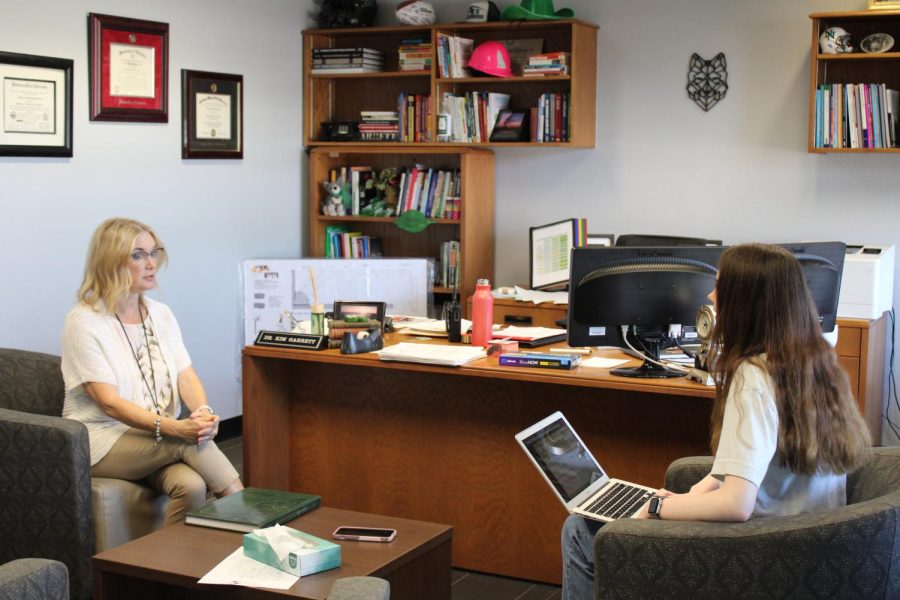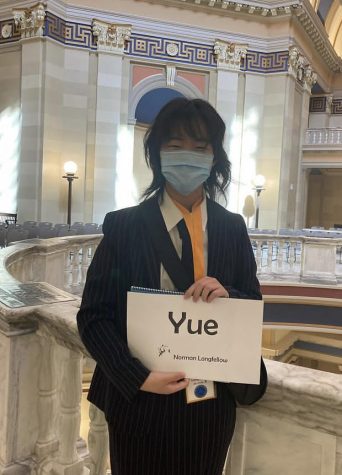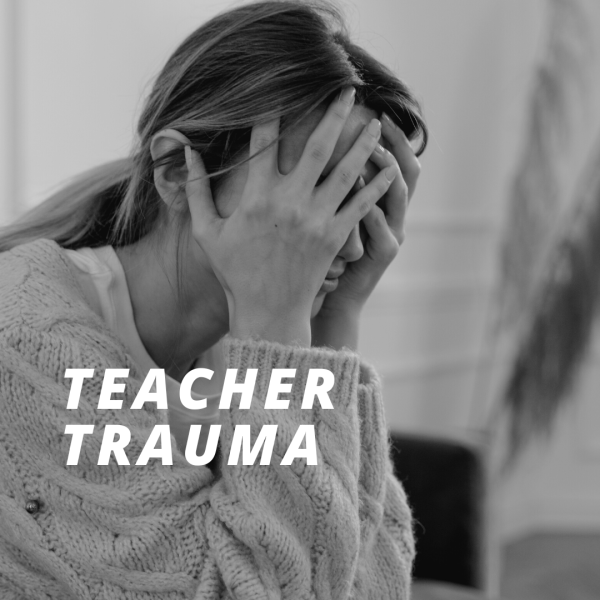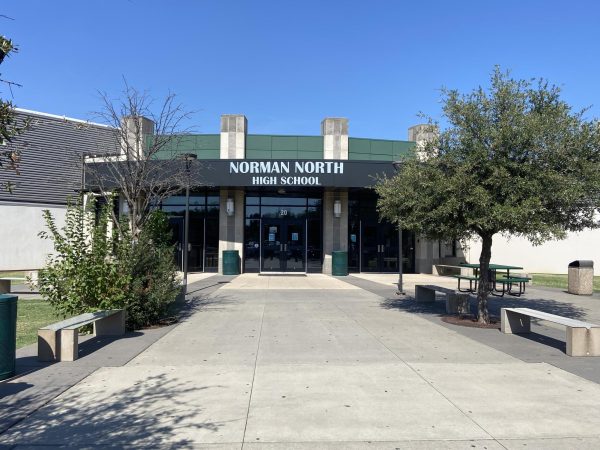New Safety Protocols-Interview With Dr. Garrett
| Liz Yue
Adia Casey interviewing Dr. Garrett about North’s new safety protocols.
September 6, 2022
With the recent news of the school shooting tragedy in Uvalde, Texas, sweeping the nation, the concern of school safety has become immensely more relevant. I sat down with Dr. Garrett Thursday, August 25th to discuss North’s response to the recent events.
Adia: Okay, so, following recent school tragedies, describe the pressure to implement safety concerns here in the North, for example, from where or what group is driving efforts.
Dr. Garrett: I don’t think we have just one group driving efforts. I don’t necessarily feel pressure; um, instead, I feel like many schools have always used school IDs. Okay, so that’s been around for a while. I’ve been in schools with them and in schools without, we know that it’s better, but we also know it’s a battle. To me what is different now with the recent shootings, is that we all recognize (everyone [recognizes]) that we have to do everything we can to keep the students in our schools safe. And while we know that wearing an ID is not the end-all-be-all, it is one piece of the safety puzzle. And so it’s really just everyone kind of recognizing the same thing. It’s time we’ve gone back and forth at North. Nobody likes the ID, including the adults, but honestly (everyone) just (I feel like) has recognized that we should do it.
Adia: Okay. What does the safety protocol team look like for any new safety regulations and who is all involved?
Dr. Garrett: There are multiple safety committees. I would say, you know…you have the district that is really working with each school system, and so we have a director of safety. We also have a director of SROs. Then, at the building level, we’re still in that process of putting our committee together. If you remember on the newsletter, students and parents can sign up to be part of that committee. And so, I know that Ms. Jaques is our building administrator who’s over safety, and so she is getting that first meeting set up with students, staff members, and parents.
The ID rule has stiffened a great deal, and IDs are now required to be worn above the waist at all times while on campus. Given how IDs have been dealt with in past school years, many students have doubts about the effectiveness of IDs, and if the ID rule will even last.
Adia: Okay, other than enforcing the ID rule, what other changes have been implemented, if any?
Dr. Garrett: Absolutely. So one of the things we also know about North is that we have not always done a great job at keeping our perimeter doors locked. So we have really talked with all staff members to make certain that they understand: it may be convenient to put a rock in a door so that somebody coming in late, you know if classroom has been outside, if a practice is early or a practice is late; but we just can’t do it. We cannot take that risk. And then, also, one of the things our district has done is just really let us know at the building level that if we have a door that is not working, they see that as top priority. And so it is our responsibility to get that reported, and then they have assured us they will also take care of that perimeter door that day. And then we’ve also, you know, we haven’t really stressed this a lot with students, but staff members know there will be consequences for doors propped open. In the past, it was more of, okay, come on don’t do that, not a good idea. But we realized, you know, we’re past the conversation. Everybody knows it’s not a good idea. If somebody does that, they are putting lives at risk. And that has to have a consequence for someone that does it, then. So that’s one thing.
We are planning more safety meetings this year. Again, safety has just risen to the top because, you know, we need to make sure everybody’s safe. Everybody wants to go home at night. You can’t learn, you can’t work if you are continually stressed about where you are and what could happen. So we had at the beginning of school with teachers, we did more with a drill really going over procedures, our police department put something together for teachers. So they went over that. We’ll have more meetings this year talking about safety, making sure that if something comes up, that we’re addressing it. Today, I had a parent who called in and had a safety concern, and so I’ve taken that information and we’re going to be doing some new things that you’ll see in just a little bit in regard to that information that was reported. Let’s see…we’ve got a couple of more. Oh, okay. So part of, okay, so you’re used to seeing drills, you know, and I’m sure you’ve had some teachers that, you know, maybe didn’t take the drill quite as seriously. So that was part of the training is really making sure that teachers know, we have to practice well. None of us want to practice for a crisis situation. We have to practice, we have to make sure that everyone knows what to do. And so we’ve…that was part of our initial training, working with teachers. We are going to hold our teachers accountable. Again, it’s past the conversation, it is, everyone-needs-to, and I feel like our staff members, like I said, there’s not any one group putting pressure, I feel like everybody has just said, yes. We need to be as safe as we can, and so, our teachers want to be as safe as they can too. We’re also going to have what’s called a reality-based, more reality-based drills. And so what that means is, you guys aren’t going to see the effects of that. But from the admin team, we will, because if you think about it, in a drill, we’re walking down the hall checking halls, well that’s not what you do in a regular crisis, so we’re going to (our Director of Security) will come over with additional SROs, and they will tell us, “okay, here’s your drill, this is what’s happening…” Then, they will check doors to make sure that people are in compliance. We will actually have a drill of “what-do-we-do” which is actually, we get in our offices and get on cameras and begin to communicate with SROs where the situation could be, and so they may even have someone walking down the, down hallways. And then we’re working to try to find that person and alert the authorities. So that’s a drill for us. The other thing too, is we’ve had this (actually my phone is on this, okay). So, we have the RAVE, which is panic button. So, in the past we have not really used it; so you can imagine if you haven’t used something, you’re not familiar with it. So, in a crisis you’re not going to know, so what we’re doing, is that we are using this as a tool, because you, so you have all these buttons that, if a staff member then, you know; it calls the police, it calls the SROs, and it calls the admin. So we are immediately alerted if there’s a true crisis. And then what’s really cool, at the bottom, there is this staff assist button. And so this is where we can use this among all of our staff members. So if we have a fight, we don’t need to call the police department, but we do want our SROs and admin. So, a teacher can go in here, and they can, first of all, it knows kind of where they are in the school anyway, it’s that kind of app, but then, they can also choose, you know, locations, like say they’re in the PAC, and then they have different choices. Maybe there’s an injury, there’s an altercation, a custom [call], IDs, or even all-clear, so we can use it at the end of our drills that we’re doing, to let everyone know that the drill is over. And then they can even decide who to send that to. So really just getting people more familiar so that if a crisis happens, they’re not afraid to use it, but are familiar with it.
Adia: And the final question, how will you ensure that the ID rule is enforced all year? Because you know, there are some kids that are just always problematic about it, and how are you going to make sure it won’t trail off at some point?
Dr. Garrett: Yeah. Um, you know, that’s, that is always true, but I also feel like your first, your first 10 days of something is really your biggest thing. And I feel like already day five, we have all IDs out. So we, you know, yes, we’re still having problems with the individual students, but that’ll be the case on anything. And so it’s just a matter of, of staying on top of it. I feel like you’re right. If safety, it’s very easy to become compliant, when if we’re not talking about safety, if we are, you know, if the news isn’t talking about safety. And I think at that point, it’s just important, hopefully by then we’re all kind of in the habit. You know, if we all have good habits, then that’s easier to keep things going. But, I think, just as an admin team, and even teachers and students, it’s important that we all say okay, it may be quiet, but it may be quiet because we’re doing what we’re supposed to be doing. So if we all hold each other accountable, then it won’t go backward, and then we’re fighting an uphill battle.











